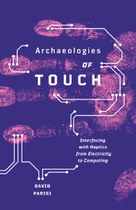A History of Haptics: Electric Eels to an Ultimate Display
 What’s interesting right now is that the fate of haptics seems tied to the fate of VR. In Archaeologies of Touch, I open with a discussion of the keynote Oculus Chief Scientist Michael Abrash gave a couple of years ago at Oculus Connect. He’s very upfront that for VR to work, it must have a robust and effective touch feedback system. But Oculus hasn’t provided that system—and Abrash states that it will take “breakthrough research” in order to make it happen, along with an entirely new programming language for rendering haptic sensations.
What’s interesting right now is that the fate of haptics seems tied to the fate of VR. In Archaeologies of Touch, I open with a discussion of the keynote Oculus Chief Scientist Michael Abrash gave a couple of years ago at Oculus Connect. He’s very upfront that for VR to work, it must have a robust and effective touch feedback system. But Oculus hasn’t provided that system—and Abrash states that it will take “breakthrough research” in order to make it happen, along with an entirely new programming language for rendering haptic sensations.
In Archaeologies of Touch, I talk about this as a “master device”—a fully-body haptic interface capable of replicating a whole range of haptic sensations, which achieves such widespread adoption that it becomes a standardized format for digitalizing touch. This lack of standardization is one of the things that’s held the diffusion of haptic interfaces back—and I’m curious to see what happens once a particular device starts to get widespread uptake. It’s what Sutherland imagined in the Ultimate Display, and it’s exactly the vision Jake lays out in your video. Marshall McLuhan has this great line: “Resenting a new technology will not halt its progress.” My resistance to a technology will not impede it, but on the flipside, my advocacy for a technology will not necessarily hasten its advance. I really try to stay on the sidelines in terms of viewing this one way or the other, but one of the things that make haptics tech so appealing to me as an object of study is its immense potential to bring about widespread changes in a whole range of human activities—from the way we work to the way we love.
By: Greg Bilsland
Story Date: 2018-01-12T05:51:00+00:00



